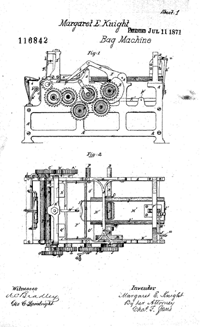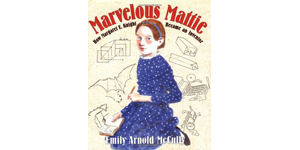A Picture Book Look at the Engineering Spirit
The desire to invent, innovate, tinker, make and build is not something limited to boys or girls, but that has not always been the case. This picture book story, based on the life of Margaret E. Knight, a female inventor and holder of one of the first patents issued to a woman in the U.S., paints a wonderful picture of a female engineer.
What do you know about the history of paper bags? Maybe not so much. Have you ever thought about how bags are mass-produced? About how a machine spits out zillions of bags over time? About the fact that before there was a machine, there was someone with a pencil, some paper, and an idea for that machine?
In the case of paper bags, the "box"-bottomed bags familiar to us are the result of engineers improving upon paper bags that had to be held open to be filled. Bags that stand open are much easier to use, and the story of the race to develop a machine to mass-produce those bags intersects with the story of a female inventor and engineer, the story of Margaret E. Knight.
Growing Up During the Industrial Revolution
I had never heard of Margaret E. Knight when I first picked up Marvelous Mattie, and at first glance, with its soft, almost vintage watercolor illustration, I wasn't sure this book would make my list. You know what they say about judging a book by its cover. I was very, very wrong and am very, very glad I have now read this book, know the story of Margaret E. Knight, and have added another wonderful title to my virtual shelf of "women in science" books for girls.
This is a fantastic picture book for introducing girls to the world of engineering and to a fairly obscure woman in science history. Written and beautifully illustrated by Emily Arnold McCully, the book does an excellent job weaving documented biographical details into an illuminating and inspiring story of a female inventor in the mid-20th century.
Born in 1938, Margaret was, according to McCully's story, an inventor from an early age. She lives with her mother and two brothers, and though the family is poor, "Mattie didn't feel poor. She had her father's toolbox."
Her father's toolbox.
With this introduction, the stones are cast. The author immediately signals that this is not a typical story of a typical girl from the mid-1900s. This is the story, from page one, of a girl who keeps a notebook of her ideas and sketches—her inventions. This is the story of a girl who uses her engineering mind to devise all kinds of wonderful solutions for her family, including toys for her brothers, an admirable kite, and a sled that is so successful on the winter hills and so popular with neighborhood kids that she makes and sells them for a quarter each.
The Engineering Design Process in Action
Mattie's life is not easy. When Mattie is twelve, she goes to work in the mills in New York. She works long and hard factory days, and yet the story focuses not on her hardship but instead on Mattie's perseverance, her optimism, and her persistent interest in machinery, engineering, and innovation.
An accident one day in the mill injures a worker. Faced with a problem (a shuttle flew off of a machine and hit someone in the head), Mattie thinks through the way the machine is supposed to work, what happened, and why. By approaching the problem analytically, she resolves to find a solution, something that could be used as a safety device to keep shuttles from flying off of looms when a thread breaks. And she succeeds. "A machine was an invention and could always be improved," the story tells readers.
McCully's attention to details supporting Mattie as an engineer are evident throughout the book and do a wonderful job highlighting steps of the engineering design process. A successful invention often involves numerous prototypes and lots of trial and error. When Mattie's kite is mentioned, readers are told that Mattie first sketched out various designs, picked the one she thought would work best, and made it. The emphasis on the iterative cycle of engineering design appears again and again throughout the story as Mattie works on a design, tests it, troubleshoots, and builds again. Readers see this same process again later when Mattie is developing her paper bag machine.
At eighteen, Mattie leaves home to work in other factories. She ends up working in a factory that makes paper bags, an early version. The race was on, however, for the development of an improved method. The story that unfolds is a story of an engineering design process that took many years, a great deal of ingenuity, and even more perseverance as Mattie fights to defend her design and claim to a patent in court.
One to Share and Talk About
Margaret Knight received more than twenty patents and developed many more original inventions. Posthumously, she was inducted into the Paper Industry International Hall of Fame and the National Inventors Hall of Fame. McCully's story fills in and fleshes out the story of this woman in science history, giving new life and color to someone who might otherwise remain largely overlooked.
That Mattie's design sketchbooks play a big part in her story is a reminder to young engineers about the value of record keeping and the role and importance of keeping a design notebook. McCully's watercolor illustrations are beautifully balanced, throughout the book, with sketchbook engineering designs. As a supplement to the book, readers and families can look online at some of the sketches from Margaret's patents.
Mattie's story is one to read with all of your children—girls and boys alike. The story of a girl and then woman who was an engineer during when many people didn't believe women could be engineers is important. We live in a different world today, but kids need to know, at all ages, that a toolbox can be a treasure trove of inspiration and invention for both boys and girls.
Machines are still machines, and they can always be improved upon.
More Science and Engineering for Girls
If you are looking for another excellent book on girls and engineering, be sure and take a look at Girls Think of Everything: Stories of Ingenious Inventions by Women. See our blog coverage of it in the "Encouraging and Inspiring Female Student Engineers" post.
See also: "Sparking Interest in Science and Science History for the Read Aloud Crowd" and "Calling Naturalists of All Ages: Citizen Science Projects for the Whole Family."
Categories:
You Might Also Enjoy These Related Posts:
- Book list for science-filled summer reading!
- New Series of Science Buddies Books
- Look Up: Bird and Astronomy Summer Reading
- Blending Science and Art with Paper Inventions
- Special Effects Fun with Nick and Tesla
- Nick and Tesla Build a Gadget Glove: Science Reading
- The Most Magnificent Thing: Science Reading
- Do Even More with Your Raspberry Pi Projects Kit













